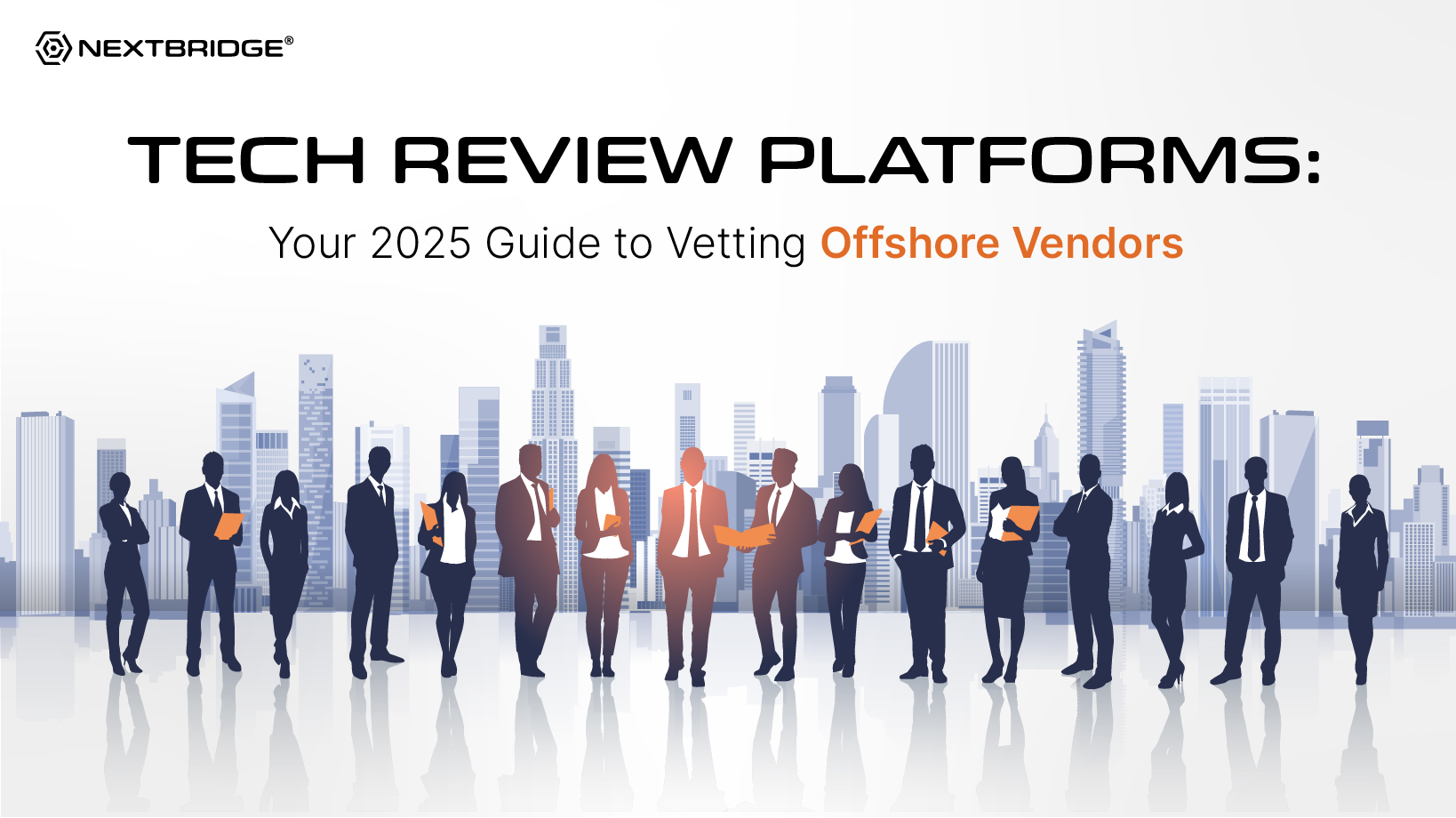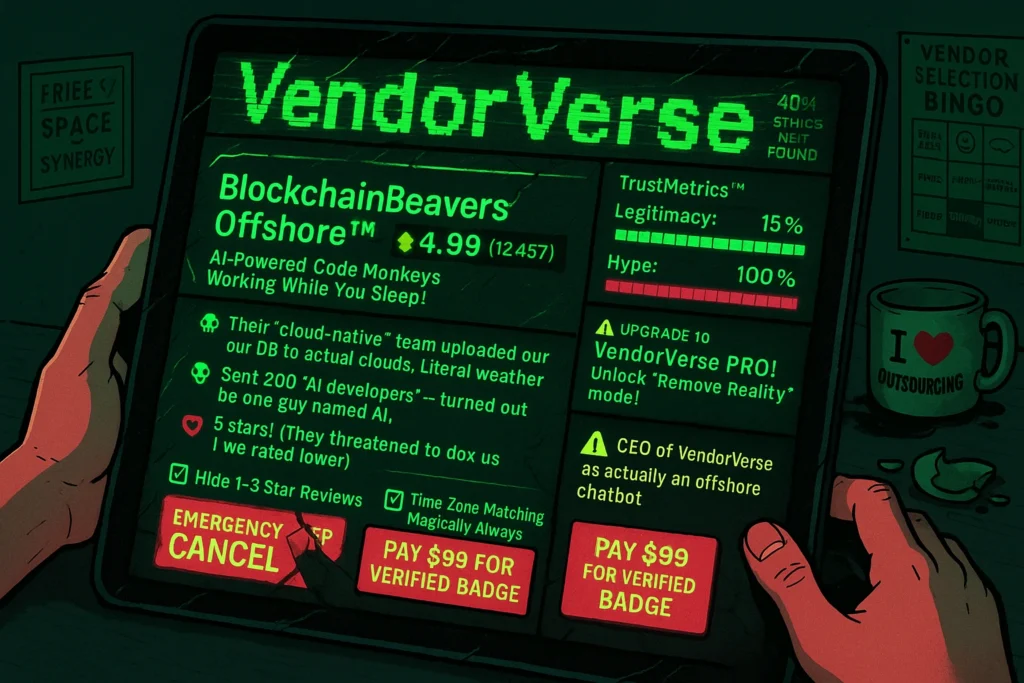 Back to all articles
Back to all articles
Blogs
Tech Review Platforms: Your 2025 Guide to Vetting Offshore Vendors


In 2025, the demand for hiring offshore software developers continues to increase, followed by cost-cutting, access to global talent, and rapid deployment. With multiple options across the globe, it is difficult to evaluate IT vendors and choose a reliable one. This is why tech review platforms exist.
As the trend of hiring offshore partners is increasing, review platforms like Clutch, GoodFirms, and DesignRush help companies evaluate IT vendors. The evaluation is based on real client feedback, technical expertise, and delivery performance. In this guide, we will help you learn how to evaluate offshore vendors and hire them confidently.
Understanding Offshore Vendor Vetting
Offshore vendor vetting is all about outsourcing your projects to a team or business in another region or country with a different time zone. The main purposes of outsourcing the project are:
- Cutting costs
- Rapid scalability
- Access to global talent
For example, you are living in the European region and outsource your project to Latin America to cut costs and speed up development.
Offshoring software projects not only benefits startups but also firms of all sizes. From small companies to large enterprises, adopting an offshoring strategy not only provides access to affordable global talent but also improves efficiency to speed up the project development. It helps them focus on their core functions and grow their business.
The Role of Tech Review Platforms in Offshore Vendor Selection
When you evaluate IT vendors and choose your offshore software partner among them, it can make ot break your tech project. As there are thousands of vendors worldwide, businesses find it difficult to compare and contrast reliable and risky service providers.

This is when tech review platforms empower them to make smarter choices through honest, transparent, and tech-oriented reviews. These platforms act as digital tools that minimize risks by simplifying the process of vendor selection.
How to Evaluate Offshore Vendors for Your Development Needs
Before jumping to evaluate offshore vendors, it is important to understand your project needs. So, ask yourself the following questions:
- Should I develop an MVP first or invest in a sophisticated solution?
- What are the objectives of the future project?
- What resources and equipment are required for the effective development of the project?
- What should be the estimated project budget?
- How does an RFP (Request for Proposal) help companies choose the best offshore vendor for their project?
- How do fixed deadlines affect the planning and execution of the project?
- How to decide which software development model best suits the project?
IT Vendor Vetting Process
Once you have evaluated your project requirements by answering the above questions, it is time to follow the IT vendor vetting process. To help you evaluate IT vendors for your next development project, we have compiled a list of factors that you can consider.
Analyze Qualifications and Skills
The competence of your software outsourcing partner is above everything. With highly qualified and skilled partners, only one supplier will be sufficient. Match the technical requirements of your projects with the technical abilities of the vendors.
The qualifications and skills must be aligned with the user experience and desired quality of the project. If vendors have worked on projects similar to yours, it is a sign that they can deliver your project effectively.
Look into Experience
Research on how much technical work experience your future vendors have in utilizing those skills and qualifications to deliver similar projects. As compared to software service providers who have just entered the industry, those with years of experience will have a significant impact on your projects.
But that is not necessary that a new vendor is unable to understand your niche. Though it will take longer for them to come up with a clear understanding. So, look for a vendor that already has a clear understanding and jump into the project initiation.
Find Client Reviews and Ratings
Keeping everything else aside, real-time client reviews and ratings tell much more about the vendors. Both determine the reputation of the vendor in the market. You can rely on these factors as they are honest and come from real-life scenarios.
Discover the Size of the Team
Determine the estimated scope of the project before contacting your technical partner. You can decide the size of the team depending on the complexity of the project. If the development takes less time, you can hire freelancers.
For more time-consuming and complex tasks, you can hire software housing firms. In case of such projects, try to hire prominent suppliers that have a large pool of applicants and internal resources.
Identify Pricing and Engagement Models
Depending on the job specialization and seniority, look into the average per-hour charges of the vendors. Next, communicate the project scope to the vendor and ask him/her to create a virtual team of qualified developers.
The engagement model determines all the costs related to the projects, including:
- Fixed price
- Time and material
- Dedicated team
After choosing the right engagement model, calculate the costs.
Consider Their Communication Skills
As English is considered a global language, you must ensure that your vendor has English conversational skills. But communication is far beyond just language. You must also consider the vendor’s frequency and openness to communicate from the beginning.
Choose the vendor only if the team is open to daily instant messages, emails, weekly calls, and video conferences. Regular reporting and updates will help your team concentrate on priority tasks.
Evaluate IP and Data Security Practices
While outsourcing your software development projects, it is important to ensure that your ideas, rights, and Intellectual Property are in safe hands. So, you must investigate to what extent the vendor follows formal agreements and legal procedures to keep your business and intellectual property safe.
Here is a list of things you must discuss with your outsourcing partner:
- NDA (Non-Disclosure Agreement)
The purpose of an NDA is to keep your concepts from being exposed to a third party. Always ensure that it is signed before your project begins to protect your ideas even after the project's completion.
- NEA (Non-employment Accord)
An NEA contract protects the interests of both parties. Once agreed upon, no other business can recruit or hire your resources and vice versa.
- Patents
A patent specifies that your business owns the product, code, wireframes, diagrams, designs, and documentation of your projects.
Tech Review Platforms
GoodFirms is considered the most reliable tech review platform in the B2B market. GoodFirms alternatives such as DesignRush, G2, and Clutch are also essential media for businesses in search of outsourcing their development needs. Such platforms mention company profile, offerings, client reviews, and ratings, which are otherwise unavailable in the market.
These platforms help you determine the credibility and reputation of a company in the market and simply software buying decisions for you. You can easily analyze what software companies can do for you and hire an ideal partner.
GoodFirms vs DesignRush
GoodFirms and DesignRush are the two critical platforms that businesses visit to evaluate IT vendors. Here is a quick comparison of both:
| Feature | GoodFirms | DesignRush |
| Primary Focus | IT services, software development, and marketing firms | Branding, digital, web design, digital agencies, and tech firms |
| Vetting Process | Detailed company profiles, verified client reviews, services, and portfolio | Expert opinions, project descriptions, top-rated listing, and client feedback |
| Review System | Star ratings with in-depth and verified client reviews | Summarized project highlights and reviews with star rating |
| Vendor Information Depth | In-depth: pricing, employee count, location, portfolio, and hourly rate | Mediocre: expertise, services, and categories |
| Global Reach | Eastern Europe and India | Focus on the USA |
| Transperency | Strong: clear reviews and details of the company | Moderate |
| Offshore Relevance | Highly relevant to rich listing | Moderately relevant with focus on branding work and agency |
| Custom Shortlisting | Personalized recommendations | Agency matching services |
| Ideal for | Hiring IT teams and vetting offshore software developers | Hiring development partners and offshoring creative branding |
Conclusion
Today’s global technical landscape demands the presence of offshore software development with attractive advantages: quick delivery, cost savings, and access to specialized talent. Yet, choosing the right outsourcing partner is a difficult decision. This decision can impact your project’s success or failure. This is the point where review platforms like GoodFirms and DesignRush help you. Use these platforms to evaluate IT vendors and choose the right one according to your technical needs.
Don't hire us right away
talk to our experts first,
Share your challenges, & then decide if we're the right fit for you! Talk to Us
Partnerships & Recognition
Commitment to excellence







